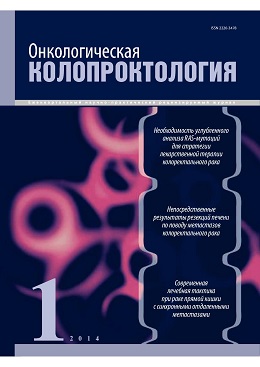Vol 3, No 1 (2014)
- Year: 2014
- Published: 23.02.2014
- Articles: 6
- URL: https://onco-surgery.info/jour/issue/view/1
EXPERT'S REPORT ON MEDICAL RECOMMENDATIONS DEVELOPED AT THE N. N. BLOKHIN RUSSIAN CANCER RESEARCH CENTER, RUSSIAN ACADEMY OF MEDICAL SCIENCES, AND PUBLISHED IN THE PAPER “COMBINED AND COMBINATION TREATMENT IN PATIENTS WITH RECTAL CANCER” BY YU. A. BARSUKO
Abstract
Представленные медицинские рекомендации посвящены результатам лечения 1101 больного раком прямой кишки различными вариантами комбинированного и комплексного лечения с использованием в предоперационном периоде программы полирадиомодификации или в сочетании данной программы с системной противоопухолевой терапией препаратами фторпиримидинового ряда (кселода).
 7-8
7-8


REVIEW
THE NECESSITY OF ADVANCED RAS-MUTATIONS INVESTIGATION FOR COLORECTAL CANCER TREATMENT
Abstract
Retrospective analysis of 3 randomized clinical trials of WT-KRAS metastatic colorectal cancer patients (PRIME, PEAK, FIRE-3) is presented. The PRIME study demonstrated increase in median overall survival (OS) in group receiving panitumumab in addition to FOLFOX4 chemotherapy – 26.0 vs 20.2 months (р = 0.04). The РЕАК trial compared FOLFOX4 + panitumumab and FOLFOX4 + bevacizumab in the same patient group in first-line treatment, a significant increase in median PFS (13.1 vs 9.5 months, p = 0.03) and non-significant increase in median OS (41.3 vs 28.9 months, p = 0.058) was achieved. The FIRE trial demonstrated FOLFIRI + cetuximab superiority when compared to FOLFIRI + bevacizumab in median OS 33.1 vs 25.6 months (р = 0.011). All trials retrospectively analyzed additional RAS mutations, allowing to select a subgroup of patients, who benefit most from EGFR inhibition.
 9-15
9-15


ORIGINAL REPORTS
IMMEDIATE RESULTS OF HEPATECTOMY FOR METASTATIC COLORECTAL CANCER
Abstract
Incorporation of bevacizumab to preoperative regional chemotherapy (CT) failed to increase the volume of intraoperative blood loss and the frequency of postoperative complications. Addition of the drug in the regional CT group significantly enhanced the rate of its effect up to 64 % and that of grade III medical pathomorphism up to 55 %. Regardless of the pattern of surgeries, the rate of complications after extended hepatectomy did not differ significantly in the treatment groups. Irrespective of treatment, the rate of acute liver failure rose when the volume of surgery was increased from conventional hemihepatectomy to extended hemihepatectomy. Acute liver failure was prominent (21%) among the complications in the treatment group. The highest incidence of acute liver failure in the comparable groups was observed in the preoperative regional CT group.
 16-22
16-22


COMPLICATED FORMS OF NON-HODGKIN’S LYMPHOMAS OF COLON AND SMALL INTESTINE
Abstract
Purpose: to estimate clinical and morphological features and results of treatment of the complicated forms of non-Hodgkin’s lymphomas of small intestine and colon.
Material and methods. Non-Hodgkin’s lymphomas of small intestine and colon are studied at 189 patients treated in N. N. Blokhin Russian Cancer Research Center during 1985–2010, in 64 cases tumor localized in colon.
Results. 20 were treated by chemotherapy, 9 were operated on for intestinal obstruction in other hospitals and 18 patients were operated on for a tumor of colon without morphological verification, and 17 patients were operated on for tumor complications in N. N. Blokhin Russian Cancer Research Center; tumor was localized in ileum in 74 cases, 26 of them received conservative treatment, 23 patients were operated due to complications in N. N. Blokhin Russian Cancer Research Center, 25 patients was operated on for ileus in other hospitals; tumor was localized in jejunum in 26 patients who all were operated on for ileus; in duodenum lymphoma was located in 25 patients from whom 18 patients were treated conservatively, and 7 had surgery because of complications. Thus, surgical interventions for ileus, bleeding or perforation on primary tumor were made in 92 (48.7 %) patients. Intestinal tumor lesion was primary in 41.0 % and secondary tumor lesion was observed in 58.9 %. 3-year overall survival in patients with uncomplicated lymphomas was 82.5 %, with complicated lymphomas – 70.1 % (p < 0,05).
Conclusions. Development of complications worsens the forecast of the overall survival in non-Hodgkin’s lymphomas of a gastrointestinal tract. It demands special approach to patients with non-Hodgkin’s lymphomas of a gastrointestinal tract because of high risk of development of surgical complications.
 23-27
23-27


THE RATE OF PATHOLOGICAL COMPLETE RESPONSE AND LONG-TERM OUTCOMES OF COMBINED TREATMENT FOR MIDDLE AND LOW RECTAL CANCER
Abstract
 28-34
28-34


CASE REPORT
CURRENT TREATMENT POLICY FOR RECTAL CANCER WITH SYNCHRONOUS DISTANT METASTASES (A CLINICAL CASE)
Abstract
Treatment results of low rectal cancer patient with internal sphincter involvement and synchronous liver metastases is presented. After combined treatment including preoperative targeted therapy, chemotherapy, chemoradiotherapy a synchronous resection of primary tumour and liver metastases was carried out (R0). Synchronous right hepihepatectomy and proctectomy was performed with resection of the deep part of external sphincter, neorectum creation by transverse coloplasty, neoanal sphincter creation using colonic smooth muscle layer without preventive colostomy. A possibility of synchronous plastic sphincter-sparing surgery in metastatic rectal cancer patient with locally advanced tumour is demonstrated. Such treatment allows to remove the risk of primary tumour complications, facilitates further chemotherapy treatment and improves quality of life and long-term treatment outcome.
 35-41
35-41











